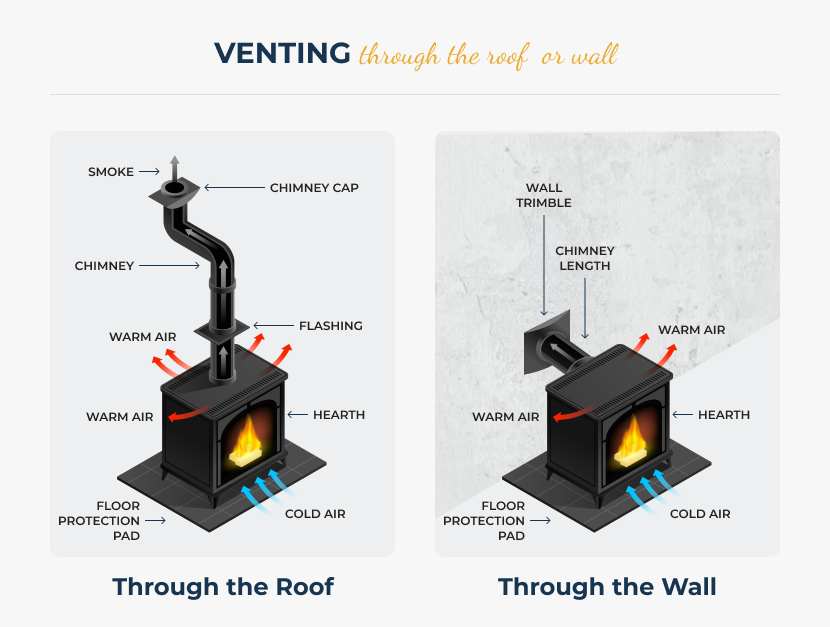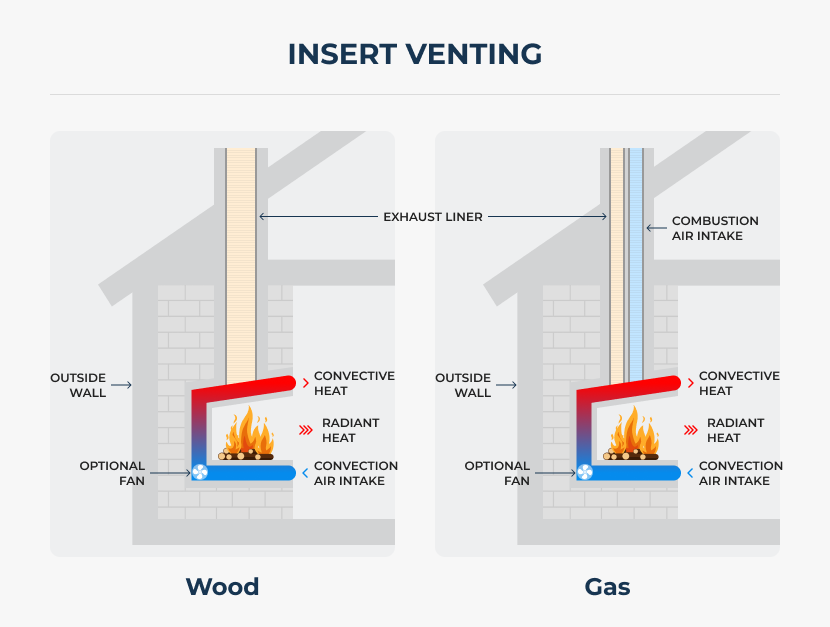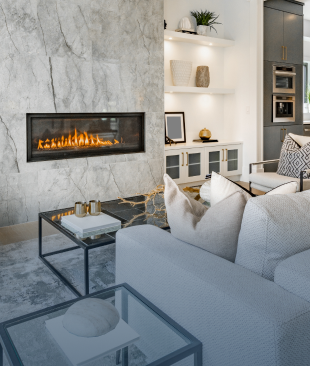Fireplaces Toronto have always been valuable home appliances, with an increasing trend of home buyers opting for properties with them. There are various fireplace types for varying preferences, allowing the acquisition of units that match every unique need. Various heating units also come with different venting options. Some, like electric or vent-free units, can function without outdoor venting, but all other types, including inserts and stoves, need vents.
Fireplace venting allows the release of combustion gases to keep the indoor air free of the harmful byproducts released when the fireplace burns. It promotes the circulation of fresh air inside the house. That is why the fireplace solution depends on venting alternatives in most properties. The availability of multiple venting options makes it more challenging to choose the ideal one – each has its pros and cons worth considering as they determine its suitability for a home.
So, what type of venting is required for a gas fireplace? The most popular venting options include direct, power, and natural draft venting.

Direct Vent
Direct vents are more common on inserts and gas fireplaces and are the most popular venting options. The technology uses two pipes on the direct vent fireplace exterior. One draws in air to fuel the flames, and the other removes combustion gases. The vents ensure that pollutants are safely away from the house, leaving clean and odourless air.
Most fireplaces with venting systems have high-temperature glass enclosures at the front to prevent pollution. They are often great for supplemental heating. Gas fireplaces or inserts are more efficient and versatile, which is why most homeowners invest in them. They do not rely on chimneys only. The units can function efficiently regardless of their placement in a house.
Direct Vent Gas Fireplace Venting Requirements
Direct vent gas fireplace venting requirements differ according to the hearth unit. Some venting systems work horizontally, and others vertically. However, the process is the same, and the components are similar. One rigid flue goes inside the other, but they have an axis, angles, and elbows. The inner flue must be smaller than the outer one to allow enough space through which clean air can reach the firebox. The inner flue carries the exhaust.
Vertical vs. Horizontal Venting
Direct vertical venting through the roof is costlier and more labour-intensive, but it is a perfect option for houses with chimneys. Other factors to consider are the unit location and the exterior property structure. The pipes go up to the roof and may not be convenient for some homeowners.
So, can you vent a gas fireplace horizontally? Horizontal venting is a solution for homeowners who prefer to install fireplaces on walls. Installation is more straightforward, involving the placement of a pipe from the back of the fireplace to the outside. The option is cheaper and more time-efficient, with the only consideration being the placement of the termination cap for the flue. Combustion fumes and possible noise as it fills can be a nuisance if the installation is not strategic.
Professional fireplace installers can give expert advice on a suitable venting method depending on your needs and intended fireplace use.
Benefits of a Direct Vent Gas Fireplace
Air quality – Concern over the quality measure of indoor air is on the rise among homeowners considering investing in fireplaces, thus magnifying the importance of direct vents. Poor ventilation causes the concentration of pollutants indoors unless there is a way of carrying the exhaust outside. That is why direct venting continues to be a preferable solution for clean air. The technology does not impact indoor air – the ability to carry all the combustion fumes outside is its main benefit.
Safety – Gas fireplaces have safety features like screens and carbon monoxide detectors. Direct vents enhance them through control valves regulating the gas flowing into the fireplace. The gas automatically turns off when the pilot light goes out. This feature assures users that gas can never build up to become hazardous.
Efficiency – A gas fireplace or insert is one of the best ways of reducing heating costs in a home because of zone heating features. Controlling the heating areas through the thermostat reduces fuel consumption and subsequent heating bills. The pilot light and temperature system promote such efficiency, but the conservation of all the heat produced also contributes. Heat wastage is impossible with a direct vent system.

Power Vent
Power vent systems are the least popular gas fireplace venting solutions, but they continue to gain popularity rapidly. Their main advantage is their ability to enhance efficiency by boosting natural airflow. An electric fan is placed on the flues to increase air circulation, whether the heating unit’s venting system is horizontal or vertical.
It is a good alternative where conventional flues cannot work, like on a freestanding wall. The fan is usually installed in the venting or termination cap, allowing you to make the venting as long or winding as you wish. The venting technology allows the placement of the heating unit anywhere.
Natural Vent
Also known as B or natural draft venting, natural venting technology is more common in fireplace inserts. It uses a brick-and-mortar chimney with the appearance of traditional wood fireplaces. The units are usually unsealed, leaving room for the appliance to suck air from the room into the combustion chamber.
The pipe leading the exhaust upwards is usually double-walled, with the outer layer acting as the insulator. The functionality depends on the heating capacity – flames create a natural draft because hot air can rise. The exhaust air can reverse back into the combustion chamber, which is why most appliances have draft hoods to prevent fluctuations by external pressure. Some hearth units also have sensors that extinguish the fire if the gases come down the flue.
Natural vent fireplaces are usually smaller than other types. They do not require large spaces for installation. However, their placement is more challenging when using a freestanding wall. Installing the unit is more straightforward if there is an opening for the insert. Inflexible venting is another common issue for most homeowners because not every home can accommodate the vertical setup.
B-vent fireplaces are the most inefficient; some have an efficiency rate of approximately 20 to 25%. They produce minimal usable heat. Even so, they are a good solution for homeowners who prefer attractive displays.

Vent-free Systems
Fireplaces that do not require venting, or electric heating units, are some of the most outstanding options for their appearance and performance. Their popularity continues to increase as their benefits become renowned. They are the easiest to install as they do not require chimneys or horizontal venting systems – installers can complete the job within a few hours. They can work in any room and are highly efficient because of the heat retention capacity within the vicinity.
Their high-temperature capacity and use of exhaust fumes mean they can save fuel. They do not have to burn for long, yet the heat will keep the room warm for longer.
So, how do you vent a gas fireplace without a chimney? Vent-free appliances rely on the air in the room to burn. The absence of a venting system is usually a significant concern for most people, but their operation makes them some of the safest options worth considering. They burn at high temperatures, consuming byproducts before they can escape into the room. That is a major contributory factor to their efficiency which is 99%. The best way to curb such concerns is to invest in a carbon monoxide detector. It is also essential to check local regulations for such installations.
Venting Options for Other Fireplace Types
Wood Burning Stoves
Gas fireplace venting requirements have some similarities with wood-burning stove options. Both options use vertical venting that releases exhaust fumes outside the house. The wood-burning hearths are always built during the property construction because the venting system must be pre-installed – the chimney goes beyond the roof line. The finishing of the roof comes afterward. Constructing the hearth requires a non-combustible board and a metal pipe that goes through a flue and chimney liner. A vertical termination cap covers the top of the liner.
Wood-burning stoves have similar venting features as fireplaces – a vertical chimney ending above the roof line. However, their design is comparable to gas fireplaces – they do not pull in air from the room but draw it from the outside. Venting them involves placing a pipe inside the chimney, unlike fireplaces that require liners only inside the chimney. The chimneys and pipes serve two purposes – they bring air into the firebox and release smoke.
Pellet Stoves
Pellet stoves and inserts are ideal for homeowners looking for low-maintenance and cheaper heating solutions. Their reliance on biomass or compressed wood as fuel makes them the most cost-efficient. They are easy to install because their venting does not require chimneys to install. Placement is possible as a DIY.
The venting system uses a combination of stainless steel and gaskets. Stainless steel lines the inner wall, and gaskets seal it.
Factors to Consider Before Buying a Fireplace Unit
Methods of venting gas fireplaces may be essential considerations when planning to purchase a heating unit, but they are not the only factor worth considering. Other components that can determine how well a fireplace serves you include:
Positioning
Fireplaces are no longer restricted to common living areas, regardless of the fuel used. Modern designs have created room for more flexible use, enabling placement in any room that requires warmth, including bedrooms and sometimes bathrooms. The many options provide the benefit of uniqueness but also make it harder to choose.
Determining the location of the hearth is one great way of narrowing down the numerous choices. Placement is directly connected to venting requirements unless you pick a vent-free unit. The size of the venting pipe matters, same as the distance to the outdoors – will the pipes run through the roof or walls? All the elements influencing the performance of the flue are fundamental.
The exact placement is also a factor – can the fireplace be placed on the upper, mid, or lower part of the wall sustaining the heater?
Purpose
Determining the exact purpose of the fireplace before installation enhances its value by ensuring the unit serves your needs for the longest time. Some homeowners prefer heating units to supply warmth in various rooms, while others use them as decorative features.
The units can work in tandem with other heating systems. Some can warm the house throughout, while others have the capacity to function occasionally. Others can be the backup, only turning on when the electricity supply is compromised. Climatic conditions and weather changes can help make that determination.
Heat output of heating capacity versus the room or house size is another vital component when considering fireplace purpose. Units with smaller heat output may not work in regions that experience extreme weather conditions during winter.
Remember to factor in the external features of the heater before a purchase. Does it complement the architectural style or interior design?
Summary
Direct vent: Direct vent fireplace exterior brings in the air for the appliance and releases all the combustion gases produced during heating. The combustion system has durable sealants to maintain indoor air quality.
Natural venting: The technology is open – not sealed. The venting system draws air from the unit’s surroundings for use in the combustion chamber. Byproducts escape through a pipe protruding on the roof.
Ventless systems: The heating units in this category have a higher burn temperature that consumes all the byproducts.
Safety remains a concern for homeowners planning to buy fireplaces, and venting is a significant element. Understanding gas fireplace venting requirements in Ontario can provide assurance, but choosing fireplace brands known for prioritizing safety is also critical. Expert consultation is also a great way to select a suitable fireplace with idyllic venting systems and performance capacity – nothing beats the expertise level of professionals. The Fireplace Store experts can help you explore the best place to vent your fireplace to ensure great returns. We have an expansive showroom you can visit to get all the answers. Feel free to visit our offices or contact us. Our one-on-one session will surely help you make an informed decision.
Toronto's Fireplace Store
Book an appointment
- +1 (416) 899-9998
- Unit 2, 535 Millway Avenue, Concord


 Website Design and SEO by dNovo Group | © 2024 All Rights Reserved – The Fireplace Store
Website Design and SEO by dNovo Group | © 2024 All Rights Reserved – The Fireplace Store



